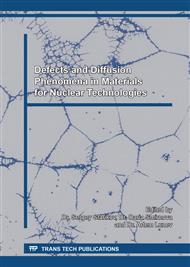[1]
M.S. Veshchunov, V.D. Ozrin, V.E. Shestak et al. Development of the mechanistic code MFPR for modelling fission-product release from irradiated UO2 fuel, Nucl. Eng. Des. 236 (2006) 179-200.
DOI: 10.1016/j.nucengdes.2005.08.006
Google Scholar
[2]
B. Feng, A. Karahan, M.S. Kazimi, Steady-state fuel behavior modeling of nitride fuels in FRAPCON-EP, J. Nucl. Mater. 427 (2012) 30-38.
DOI: 10.1016/j.jnucmat.2012.04.011
Google Scholar
[3]
M.S. Veshchunov, A.V. Boldyrev, A.V. Kuznetsov et al., Development of the advanced mechanistic fuel performance and safety code using the multi-scale approach, Nucl. Eng. Des. 295 (2015) 116-126.
DOI: 10.1016/j.nucengdes.2015.09.035
Google Scholar
[4]
T. Barani, E. Bruschi, D. Pizzocri et al., Analysis of transient fission gas behaviour in oxide fuel using BISON and TRANSURANUS, J. Nucl. Mater. 486 (2017) 96-110.
DOI: 10.1016/j.jnucmat.2016.10.051
Google Scholar
[5]
M.R. Tonks, D. Andersson, S.R. Phillpot et al., Mechanistic materials modeling for nuclear fuel performance, Annals of nuclear energy 105 (2017) 11-24.
DOI: 10.1016/j.anucene.2017.03.005
Google Scholar
[6]
V.J. Tennery, T.G. Godfrey, R.A. Potter, Sintering of UN as a function of temperature and N2 pressure, J. Am. Ceram. Soc. 54 (1971) 327-331.
DOI: 10.1111/j.1151-2916.1971.tb12306.x
Google Scholar
[7]
H. Matzke, Science of Advanced LMFBR Fuels: Solid State Physics, Chemistry and Technology of Carbides, Nitrides and Carbonitrides of Uranium and Plutonium, North-Holland, (1986).
Google Scholar
[8]
E. Kotomin, Y. Mastrikov, S. Rashkeev, P. Van Uffelen, Implementing first principles calculations of defect migration in a fuel performance code for UN simulations, J. Nucl. Mater. 393 (2009) 292-299.
DOI: 10.1016/j.jnucmat.2009.06.016
Google Scholar
[9]
M. Klipfel, P. Van Uffelen, Ab initio modelling of volatile fission products in uranium mononitride, J. Nucl. Mater. 422 (2012) 137.
DOI: 10.1016/j.jnucmat.2011.12.018
Google Scholar
[10]
A. Claisse, T. Schuler, D.A. Lopes, P. Olsson, Transport properties in dilute UN(X) solid solutions (X=Xe, Kr), Phys. Rev. B, 94 (2016) 174302.
Google Scholar
[11]
A. Yu. Kuksin, S.V. Starikov, D.E. Smirnova, V.I. Tseplyaev, The diffusion of point defects in uranium mononitride: Combination of DFT and atomistic simulation with novel potential, J. All. Comp. 658 (2016) 385-394.
DOI: 10.1016/j.jallcom.2015.10.223
Google Scholar
[12]
H. Mehrer, Diffusion in Solids: Fundamentals, Methods, Materials, Diffusion-Controlled Processes (Springer Series in Solid-State Sciences), Springer, (2007).
DOI: 10.1007/978-3-540-71488-0
Google Scholar
[13]
Yu.F. Khromov, R.A. Lyutikov, Certain thermodynamic properties of uranium nitride UNy, Atomic Energy 49 (1980) 448-452 (translated from Russian).
DOI: 10.1007/bf01123922
Google Scholar
[14]
R. Benz, W.B. Hutchinson, U + N2 reaction layer growth, J. Nucl. Mater. 36 (1970) 135-146.
Google Scholar
[15]
G. Kresse, J. Furthmüller, Efficient iterative schemes for ab initio total-energy calculations using a plane-wave basis set, Phys. Rev. B. 54 (16) (1996) 11169.
DOI: 10.1103/physrevb.54.11169
Google Scholar
[16]
H. Tagawa, Phase relations and thermodynamic properties of the uranium-nitrogen system, J. Nucl. Mater. 51 (1974) 78-89.
Google Scholar
[17]
S.L. Hayes, J.K. Thomas, K.L. Peddicord, Material property correlations for uranium mononitride: IV. thermodynamic properties, J. Nucl. Mater. 171 (1990) 300-318.
DOI: 10.1016/0022-3115(90)90377-y
Google Scholar
[18]
A.Y. Kuksin, D.E. Smirnova, Calculation of diffusion coefficients of defects and ions in UO2, Phys. Solid State 56 (2014) 1214-1223.
DOI: 10.1134/s1063783414060201
Google Scholar
[19]
M. Klipfel, V. Di Marcello, A. Schubert et al. Towards a multiscale approach for assessing fission product behaviour in UN, J. Nucl. Mater. 442 (2013) 253-261.
DOI: 10.1016/j.jnucmat.2013.08.056
Google Scholar
[20]
J.B. Holt, M.Y. Almassy, Nitrogen diffusion in uranium nitride as measured by alpha particle activation of 15N, J. Am. Ceram. Soc. 52 (1969) 631-635.
DOI: 10.1111/j.1151-2916.1969.tb16064.x
Google Scholar
[21]
M.H. Bradbury, H. Matzke, Self-diffusion of plutonium in uranium-plutonium mononitride, J. Nucl. Mater. 75 (1978) 68-76.
DOI: 10.1016/0022-3115(78)90029-6
Google Scholar
[22]
T.J. Sturiale, M.A. DeCrescente, Self diffusion of nitrogen in uranium mononitride, Tech. Rept. PWAC-477, Contract At(30-1)-2789; 25 pp., September 1965; pp.1-25.
Google Scholar
[23]
D.K. Reimann, D.M. Kroegbr, T.S. Lundy, Cation self-diffusion in UN1+x , J. Nucl. Mater. 38 (1971) 191-196.
DOI: 10.1016/0022-3115(71)90042-0
Google Scholar
[24]
H. Matzke, Point defects and transport properties in carbides, Solid State Ionics 12 (1984) 25-45.
DOI: 10.1016/0167-2738(84)90128-0
Google Scholar
[25]
P. Brommer, F. Gähler, Effective potentials for quasicrystals from ab-initio data, Phil. Mag. 86 (2006) 753-758.
DOI: 10.1080/14786430500333349
Google Scholar
[26]
P. Brommer, A. Kiselev, D. Schopf, P. Beck, J. Roth, H. -R. Trebin, Classical interaction potentials for diverse materials from ab initiodata: a review of potfit, Modell. Simul. Mater. Sci. Eng. 23 (7) (2015) 074002.
DOI: 10.1088/0965-0393/23/7/074002
Google Scholar
[27]
J. Melehan, J. Gates, Battelle Memorial Institute, Report No. BMI-1701, (1964).
Google Scholar
[28]
N. Oi, Xe-133 diffusion in UN single crystals, Z . Naturforschg 21a (1966) 863-864.
DOI: 10.1515/zna-1966-0641
Google Scholar
[29]
H. Blank, in: R.W. Cahn et al. (Eds. ), Materials Science and Technology, vol. 10A, Weinheim, New York, 1994, p.191.
Google Scholar
[30]
R. Thetford, M. Mignanelli, The chemistry and physics of modelling nitride fuels for transmutation, J. Nucl. Mater. 320 (2003) 44-53.
DOI: 10.1016/s0022-3115(03)00170-3
Google Scholar
[31]
V.D. Ozrin, A model for evolution of oxygen potential and stoichiometry deviation in irradiated UO2 fuel, J. Nucl. Mater. 419 (2011) 371-377.
DOI: 10.1016/j.jnucmat.2011.06.042
Google Scholar
[32]
D. Yu. Lubimov, A.V. Androsov, G.S. Bulatov, K.N. Gedgovd, Thermodynamic modeling of the phase composition of mixed uranium-plutonium mononitride under fast-neutron irradiation to burn-up 80 GW days/ton and temperature 900–1400 K", Atomic Energy 114 (2013).
DOI: 10.1007/s10512-013-9704-0
Google Scholar
[33]
M.S. Veshchunov, R. Dubourg, V.D. Ozrin, V.E. Shestak, V.I. Tarasov, Mechanistic modelling of urania fuel evolution and fission product migration during irradiation and heating, J. Nucl. Mater. 362 (2007) 327-335.
DOI: 10.1016/j.jnucmat.2007.01.081
Google Scholar
[34]
Y. Arai, A. Maeda, K. Shiozawa, T. Ohmichi, Chemical forms of solid fission products in the irradiated uranium-plutonium mixed nitride fuel, J. Nucl. Mater. 210 (1994) 161-166.
DOI: 10.1016/0022-3115(94)90233-x
Google Scholar
[35]
H. Tagawa, Equilibrium nitrogen pressures and thermodynamic properties of uranium sesquinitride, J. Nucl. Mater. 41 (1971) 313-319.
DOI: 10.1016/0022-3115(71)90168-1
Google Scholar
[36]
P. -Y. Chevalier, E. Fischer, B. Cheynet, Thermodynamic modelling of the N–U system, J. Nucl. Mater. 280 (2000) 136-150.
Google Scholar


